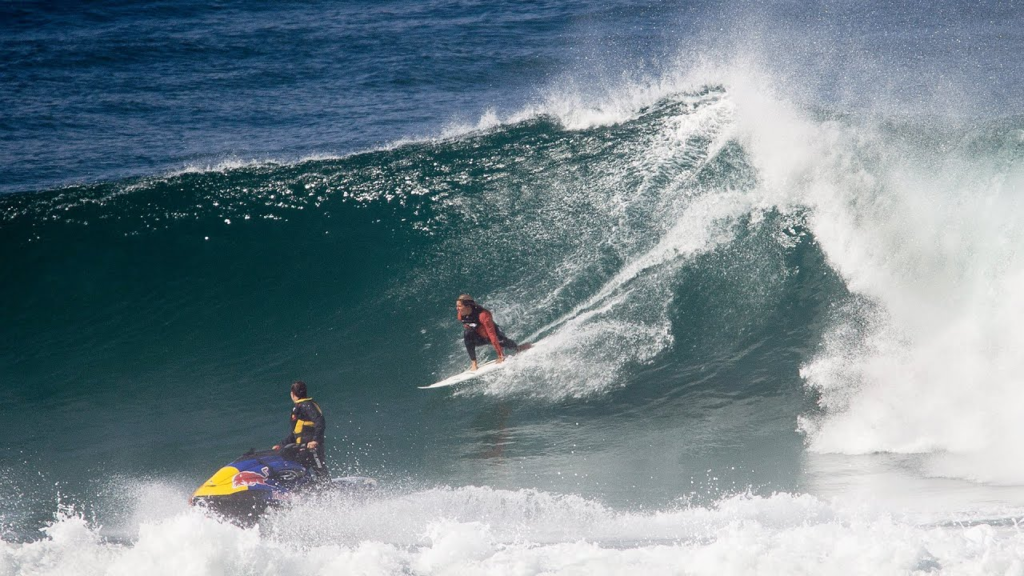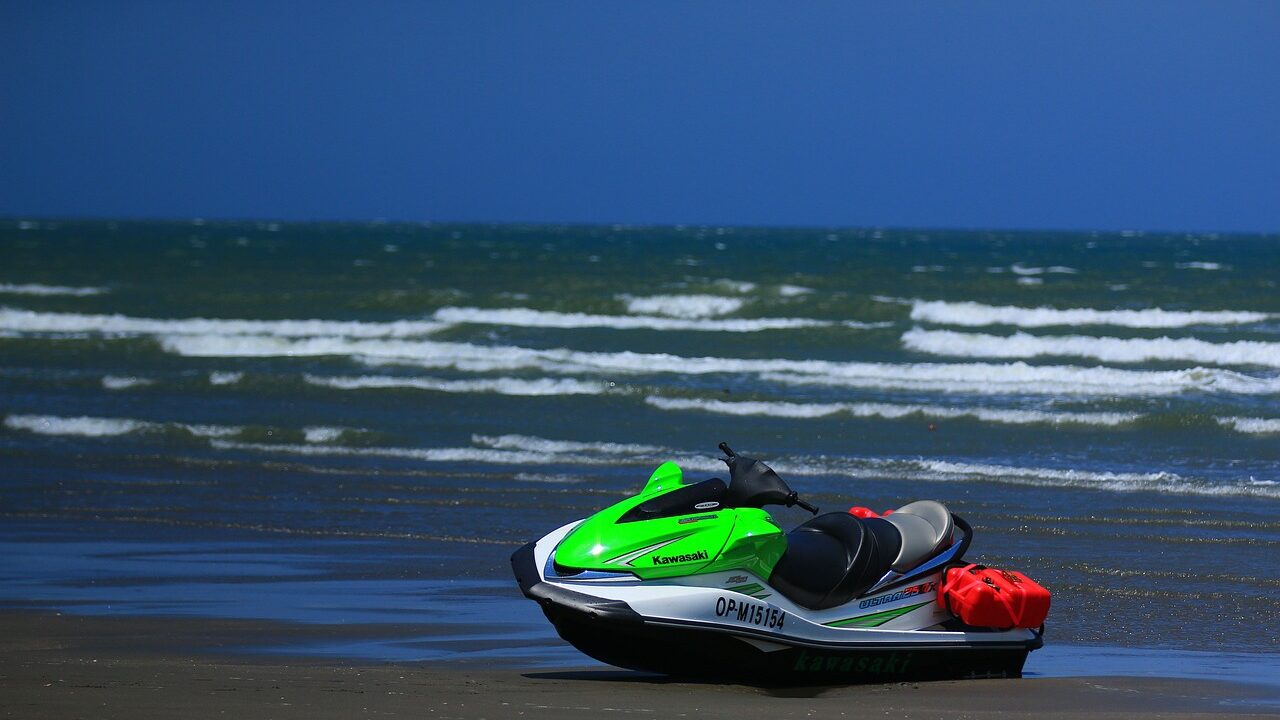
Table of Contents
I. History of Tow-In Surfing
Traditional Surfing vs. Tow-In Surfing
Understanding the roots of Tow-In Surfing requires a glance back at the timeless tradition of classic wave riding. In the early days, surfers relied on their own stamina, paddling skill, and a deep connection with the sea to navigate the waves. This traditional approach, while intimate and elemental, had its limits when it came to facing the ocean’s colossal giants.
Enter Tow-In Surfing, a paradigm shift in the surfing narrative. Here, the narrative changes from paddling against the waves to a collaborative dance between surfers and jet skis. The surfer, once solely reliant on the push and pull of nature, now partners with a powerful watercraft to access waves that defy the conventional boundaries of traditional surfing.
Pioneers of Tow-In Surfing
The journey of Tow-In Surfing from novelty to mainstream sport owes much to the trailblazers who dared to reimagine the surfer’s relationship with the waves. Figures like Laird Hamilton and Dave Kalama emerged as pioneers during the 1990s, strapping themselves to jet skis and venturing into uncharted waters, both literally and metaphorically.
These visionaries not only challenged the physical limits of wave riding but also sparked a movement that embraced the fusion of human skill and technological innovation, forever altering the course of surfing history.
Milestones in Tow-In Surfing
As Tow-In Surfing carved its niche, pivotal moments etched their mark on its evolutionary timeline. What began as experimental towing transformed into organized efforts, marking a shift from daring exploration to recognized discipline. These milestones underscored not just the prowess of surfers but also the marriage of daring spirit and cutting-edge technology that turned Tow-In Surfing into a respected chapter within the broader surfing community.
The journey doesn’t stop here; the next dive takes us into the mechanics of Tow-In Surfing, unraveling the intricate dance between surfers, jet skis, and the mighty waves that beckon them.
II. How Does Tow-In Surfing Work?
Tow-In Surfing Basics
Tow-In Surfing isn’t just a matter of being pulled into a wave; it’s a symphony of coordination, skill, and precision. Let’s break down the basics:
At its essence, Towing in Tow-In Surfing involves using a watercraft, typically a jet ski, to tow the surfer into a wave. The surfer, armed with a tow rope, relinquishes the traditional paddle, allowing the external force of the jet ski to propel them at high speeds into waves that would be otherwise unattainable.
Equipment plays a crucial role in Tow-In Surfing. Specially designed surfboards with increased volume and specific tow boards, along with sturdy tow ropes, form the arsenal. These specialized tools empower surfers to navigate and conquer waves that push the boundaries of traditional surfing.
The Role of Jet Skis and Watercraft
Jet skis serve as the trusty steeds of Tow-In Surfing. Their maneuverability, speed, and ability to navigate through turbulent waters make them the ideal partner for surfers tackling colossal waves. The jet ski not only tows the surfer but also provides a swift escape route when faced with the formidable power of the ocean.
Tow-In Surfing is a dance of collaboration. Communication between the surfer and the jet ski operator is paramount. This collaboration involves precise timing, strategic positioning, and a deep understanding of the wave dynamics. The seamless partnership between human intuition and machine precision is what sets Tow-In Surfing apart as a dynamic water sport.

Mechanics of Tow-In Surfing
Not all waves are created equal. Tow-In Surfing requires a keen eye for selecting the right waves – those with sufficient size, power, and shape. Surfers, often relying on the guidance of their towing partners, analyze the ocean’s ever-changing dynamics to pick the perfect canvas for their ride.
Success in Tow-In Surfing hinges on perfect timing and positioning. Surfers must be in the right place at the right time to catch the wave’s energy and harness its power. This delicate dance between surfer, jet ski, and wave demands split-second decision-making and a synergy of skills that borders on the extraordinary.
As we unravel the intricate mechanics of Tow-In Surfing, the next segment explores the advancements and innovations that have propelled this dynamic water sport into the forefront of surfing evolution.
III. Advancements and Innovations in Tow-In Surfing
Technological Developments
Tow-In Surfing has ushered in a wave of innovation in surfboard design. Traditional surfboards were fine-tuned for paddling, but the demands of being towed into mammoth waves require a different approach. Tow boards, characterized by increased volume, specialized shapes, and materials, provide the stability and control necessary for navigating the powerful swells encountered in Tow-In Surfing.
The gear used in Tow-In Surfing has evolved alongside the sport itself. From robust tow ropes engineered to withstand intense forces to safety vests equipped with inflatable devices, every piece of equipment plays a crucial role in ensuring a surfer’s safety and performance. Technological advancements in materials and design continue to push the boundaries of what’s possible in Tow-In Surfing.
Impact on Surfing Competitions
Tow-In Surfing has not only transformed the way waves are conquered but has also given rise to specialized competitions. Tow-In Surfing contests bring together the world’s top riders in an adrenaline-fueled showcase of skill and daring. These events, often held in locations with renowned big waves, have become a thrilling spectacle for both participants and spectators.
The impact of Tow-In Surfing extends beyond competitions, influencing the broader surfing community. Once considered a niche pursuit, Tow-In Surfing is now recognized as a legitimate and exhilarating form of wave riding. Its influence has permeated surf culture, inspiring a new generation of surfers to explore the possibilities of riding waves that were once deemed unreachable.
In the upcoming section, we’ll navigate the risks and challenges inherent in Tow-In Surfing, shedding light on the safety concerns, environmental considerations, and the importance of responsible practices in this high-octane water sport.
IV. Risks and Challenges
Safety Concerns in Tow-In Surfing
Tow-In Surfing, while delivering an adrenaline-packed experience, comes with its share of safety considerations. The sheer size and power of the waves tackled in this discipline pose inherent risks. Surfers, propelled by jet skis, navigate waves that can reach towering heights, demanding not only skillful riding but also an acute awareness of the potential dangers lurking in the surging waters.
The synergy between surfer and towing partner is the linchpin of Tow-In Surfing safety. Effective communication is essential, considering the split-second decisions required in the face of powerful waves. The ability to synchronize movements, read wave patterns, and make rapid adjustments ensures a seamless collaboration between the surfer and the jet ski operator, reducing the risk of mishaps.
Environmental Considerations
The pursuit of massive waves in Tow-In Surfing is not without environmental repercussions. The use of jet skis and motorized watercraft raises concerns about their impact on coastal ecosystems. As the popularity of Tow-In Surfing grows, it becomes imperative for surfers and organizers to adopt responsible practices that mitigate potential harm to marine life and the delicate balance of coastal environments.
Tow-In Surfing enthusiasts and organizers play a crucial role in minimizing the environmental footprint of this high-energy sport. Adhering to guidelines that prioritize marine conservation, respecting marine life habitats, and promoting sustainable event practices are essential steps. The aim is to ensure that the thrill of Tow-In Surfing doesn’t compromise the health and integrity of the very waves surfers seek to conquer.
In the concluding section, we’ll unravel the intriguing story of who invented Tow-In Surfing, exploring its origins, key influencers, and the evolution of this exhilarating water sport into a globally recognized discipline.
V. Who Invented Tow-In Surfing?
Origins of the Concept
The inception of Tow-In Surfing is a tale woven by daring visionaries who sought to redefine the boundaries of wave riding. While pinpointing a single inventor is challenging, influential figures like Laird Hamilton and Dave Kalama played pivotal roles in the conceptualization and popularization of Tow-In Surfing during the early 1990s.
Tow-In Surfing emerged from a series of key moments where surfers pushed the limits of conventional paddling. The realization that certain waves were beyond the reach of traditional surfing methods sparked the idea of using external power to conquer these colossal swells. These pivotal moments marked the birth of a revolutionary approach to riding waves.

The Evolution of Tow-In Surfing
Tow-In Surfing evolved from an experimental concept into a global phenomenon. The daring exploits of surfers tackling monstrous waves with the aid of jet skis garnered attention and awe. This newfound form of wave riding captured the imagination of the surfing community, propelling Tow-In Surfing into the spotlight as an extreme sport that blurred the lines between skill, technology, and the raw power of the ocean.
The evolution of Tow-In Surfing is a collaborative effort that extends beyond the surfers themselves. Towing partners, often skilled jet ski operators, became indispensable allies in the quest for conquering the biggest waves. The seamless coordination between surfers and their towing counterparts elevated Tow-In Surfing into a dynamic partnership, showcasing the fusion of human determination and technological innovation.
As we conclude this exploration into the origins of Tow-In Surfing, the final section will reflect on its dynamic nature, discuss future prospects and innovations, and emphasize the importance of fostering safe and responsible practices in this exhilarating water discipline.
VI. Conclusion | What is Tow-In Surfing
In the grand tapestry of wave riding, Tow-In Surfing stands as a dynamic and ever-evolving discipline that has redefined the limits of what surfers can achieve. From its humble origins rooted in the vision of pioneers to its current status as a globally recognized extreme sport, Tow-In Surfing has woven a narrative that seamlessly combines human skill with technological prowess.
As Tow-In Surfing continues to ride the crest of innovation, the future holds exciting prospects. Surfboard design, towing mechanisms, and safety gear are likely to undergo further advancements, pushing the boundaries of what’s possible in conquering the ocean’s mightiest waves. The ongoing marriage of technological innovation and the surfer’s indomitable spirit promises a thrilling evolution for Tow-In Surfing.
With great excitement comes a responsibility to safeguard both the athletes and the environment. Tow-In Surfing, with its adrenaline-pumping nature, requires a commitment to safety and environmental stewardship. Emphasizing responsible practices, effective communication, and eco-friendly approaches in organizing events will be pivotal in ensuring the continued growth of Tow-In Surfing without compromising the delicate balance of our oceans.
As we conclude this exploration into the captivating world of Tow-In Surfing, let the waves of innovation and daring spirit continue to propel surfers into uncharted waters. May Tow-In Surfing, with its unique blend of tradition and technology, ride the waves of the future with both thrill-seekers and the natural world in mind.
